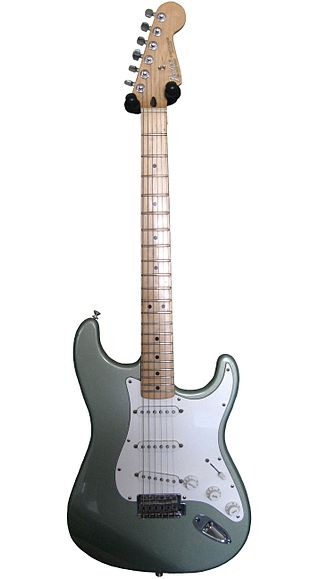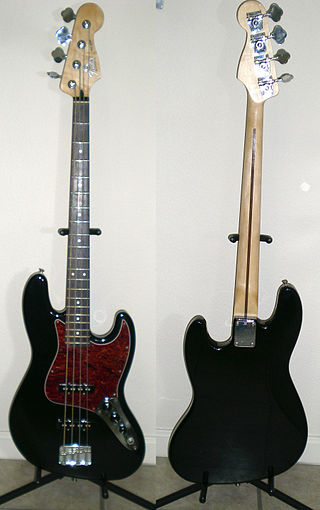
The bass guitar, electric bass or simply bass is the lowest-pitched member of the guitar family. It is a plucked string instrument similar in appearance and construction to an electric or acoustic guitar, but with a longer neck and scale length, and typically four to six strings or courses. Since the mid-1950s, the bass guitar has largely come to replace the double bass in popular music due to its lighter weight, the use of frets and, most importantly, its design for electric amplification.
Ibanez is a Japanese guitar brand owned by Hoshino Gakki. Based in Nagoya, Aichi, Japan, Hoshino Gakki were one of the first Japanese musical instrument companies to gain a significant foothold in import guitar sales in the United States and Europe, as well as the first brand of guitars to mass-produce the seven-string guitar and eight-string guitar. Ibanez manufactures effects, accessories, amps, and instruments in Japan, China, Indonesia, and the United States. As of 2017 they marketed nearly 165 models of bass guitar, 130 acoustic guitars, and more than 300 electric guitars. After Gibson and Fender, Ibanez is considered the third biggest guitar brand.

The Fender Stratocaster, colloquially known as the Strat, is a model of electric guitar designed between 1952 and 1954 by Leo Fender, Bill Carson, George Fullerton, and Freddie Tavares. The Fender Musical Instruments Corporation has continuously manufactured the Stratocaster since 1954. It is a double-cutaway guitar, with an extended top "horn" shape for balance. Along with the Gibson Les Paul, Gibson SG, and Fender Telecaster, it is one of the most-often emulated electric guitar shapes. "Stratocaster" and "Strat" are trademark terms belonging to Fender. Guitars that duplicate the Stratocaster by other manufacturers are sometimes called S-Type or ST-type guitars.
The Fender Zone is a fretted electric bass guitar, introduced in 2001.
The Fender Jaguar is an electric guitar by Fender Musical Instruments characterized by an offset-waist body, a relatively unusual switching system with two separate circuits for lead and rhythm, and a short-scale 24" neck. Owing some roots to the Jazzmaster, it was introduced in 1962 as Fender's feature-laden top-of-the-line model, designed to lure players from Gibson. During its initial 13-year production run, the Jaguar did not sell as well as the less expensive Stratocaster and Telecaster, and achieved its most noticeable popularity in the surf music scene. After the Jaguar was taken out of production in 1975, vintage Jaguars became popular first with American punk rock players, and then more so during the alternative rock, shoegazing and indie rock movements of the 1980s and 1990s. Fender began making a version in Japan in the mid-1980s, and then introduced a USA-made reissue in 1999. Since then, Fender has made a variety of Jaguars in America, Mexico, Indonesia and China under both the Fender and Squier labels. Original vintage Jaguars sell for many times their original price.

The Fender Precision Bass is a model of electric bass guitar manufactured by Fender Musical Instruments Corporation. In its standard, post-1957 configuration, the Precision Bass is a solid body, four-stringed instrument usually equipped with a single split-coil humbucking pickup and a one-piece, 20-fret maple neck with rosewood or maple fingerboard.

The Fender Jazz Bass is the second model of electric bass created by Leo Fender. It is distinct from the Precision Bass in that its tone is brighter and richer in the midrange and treble with less emphasis on the fundamental frequency. The body shape is also different from the Precision Bass, in that the Precision Bass has a symmetrical lower bout on the body, designed after the Telecaster and Stratocaster lines of guitars, while the Jazz Bass has an offset lower bout, mimicking the design aesthetic of the Jaguar and Jazzmaster guitars.
The Fender Bass VI, originally known as the Fender VI, is a six-string electric bass guitar made by Fender.

The Squier '51 is an electric guitar made by Squier, a subsidiary of Fender. The '51 is notable for being one of the few original designs made by Squier, which normally manufactures less expensive authorized copies of Fender's popular guitars and bass guitars.
The Fender Mustang Bass is an electric bass guitar model produced by Fender and Squier. Two variants, the Musicmaster Bass and the Bronco Bass, have also been produced from time to time using the same body and neck shape.

The Fender Jaguar Bass is an electric bass guitar currently manufactured in Mexico by the Fender Musical Instruments Corporation.
The Fender Telecaster Bass is an electric bass introduced in 1968 by Fender Musical Instruments Corporation. With few physical changes through the 1970s, it was discontinued in 1979 and reissued in 2007 by Fender's subsidiary Squier as the Squier Vintage Modified Precision Bass TB, which was discontinued in 2014.

Greco is a Japanese guitar brand owned by the Kanda Shokai Corporation (in Japanese) 神田商会, a musical instrument wholesaler mostly known for being part of Fender Japan. Instruments manufactured with the name "Greco" are electric and acoustic guitars.

The Fender Aerodyne Jazz Bass is an electric bass guitar created by Fender and was first introduced at Winter NAMM 2003. In 2022, Fender discontinued the Aerodyne after nearly 20 years of production.
The Fender Prodigy is a discontinued model of electric guitar produced by Fender from 1991 to 1993. It is one of Fender's attempts to compete with the superstrat-style guitars produced by Ibanez, Jackson/Charvel, Carvin Corporation and Yamaha. Since the Prodigy series was discontinued after about two and half years of production without a clear reason, it is considered one of Fender's rare models because of its limited production. Fender also produced a Prodigy Bass based on the Precision Bass Plus Deluxe featuring a P/J pickup layout (P as in Fender Precision Bass and J as in Fender Jazz Bass), 2-band active circuitry and a "fine-tuner" Schaller Elite bridge assembly.
The Fender American Deluxe Series was a line of electric guitars and basses introduced by Fender in 1995 and discontinued in 2016. It was upgraded in 2004 and 2010 before being replaced by the American Elite series in 2016.
The Fender Elite Stratocaster is an electric solid body guitar that was manufactured by Fender in 1983 and 1984. The name was revived from 2016 to 2019 with the Fender American Elite Stratocaster Series.
The Fender Prophecy II Bass was a Japanese-made, limited-edition bass guitar which was a significant departure from the well-known traditional Precision Bass and Jazz Bass. It was actually produced by Heartfield in Japan's Fujigen Gakki factory.
The Fender Telecaster, colloquially known as the Tele, is an electric guitar produced by Fender. Together with its sister model the Esquire, it was the world's first mass-produced, commercially successful solid-body electric guitar. Its simple yet effective design and revolutionary sound broke ground and set trends in electric guitar manufacturing and popular music.
Blade Guitars is a manufacturer of electric guitars and bass guitars founded by luthier Gary Levinson in 1987. Levinson had been repairing guitars since 1964 and, in 1977, during his graduate studies at the University of Basel, Switzerland, he founded Guitars by Levinson. Using the experience he gathered from his work, he decided to start Blade Guitars in 1985. By 1986, he was refining the idea of a line of guitars based on the concept he defines as "Classic Design, Creative Technology"; at this time, he was also determining the features that would characterize his range of guitars. In January 1987, a manufacturing deal was reached for the production of the guitars. Blade Guitars made their debut in October 1987, at the music show of Tokyo. Their presentation at the Frankfurt Musikmesse in 1988 signalled their European launch.











